
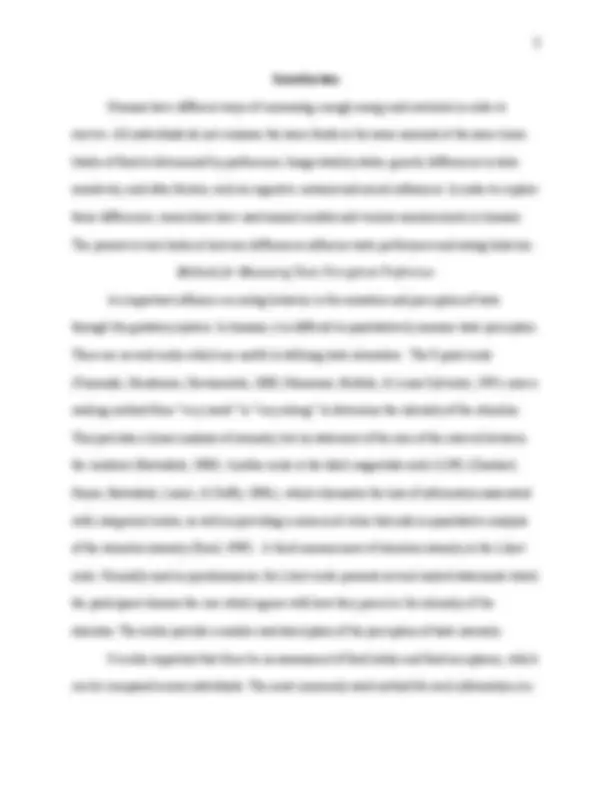
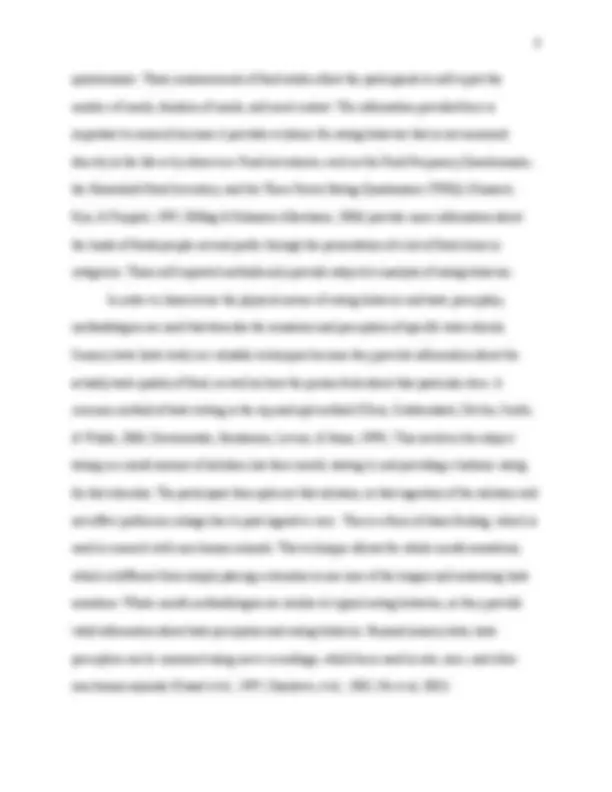
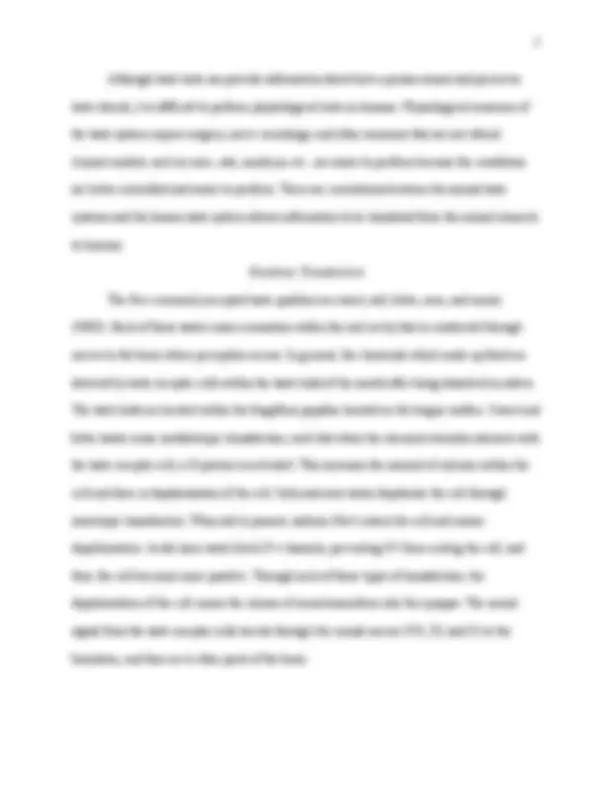
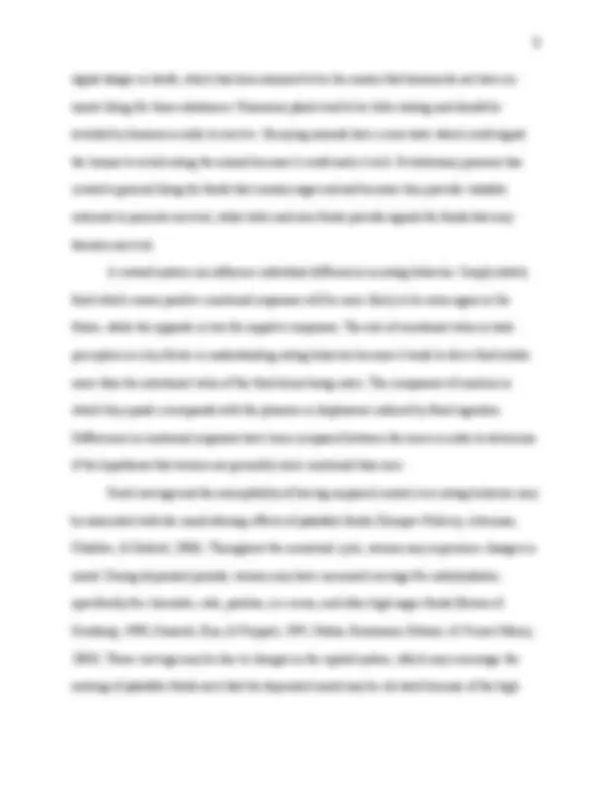
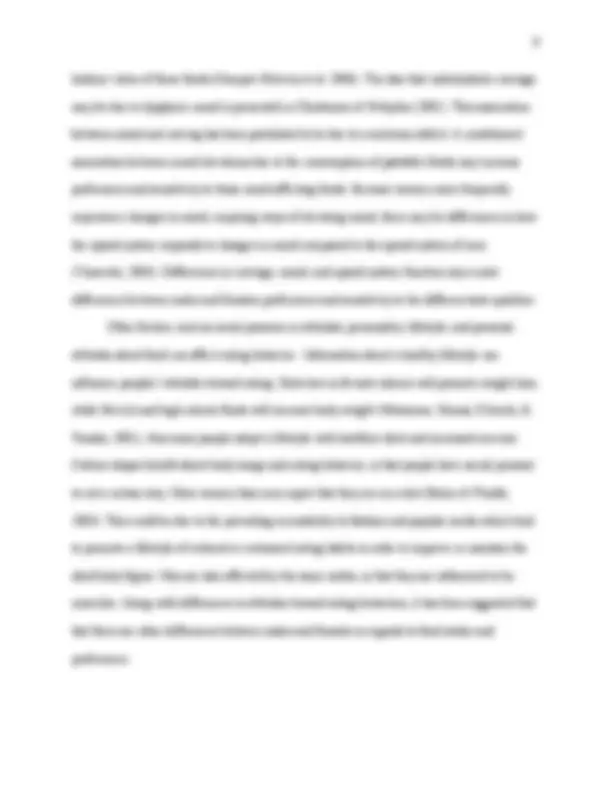
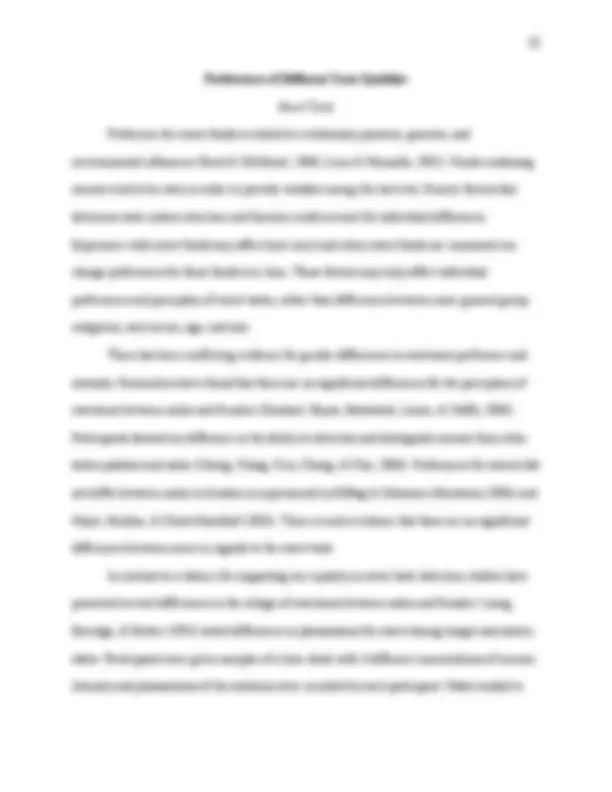
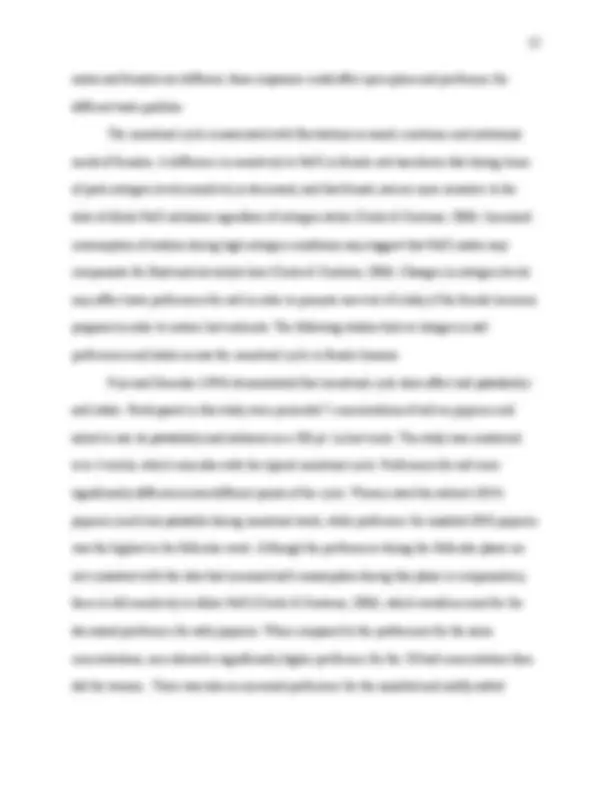
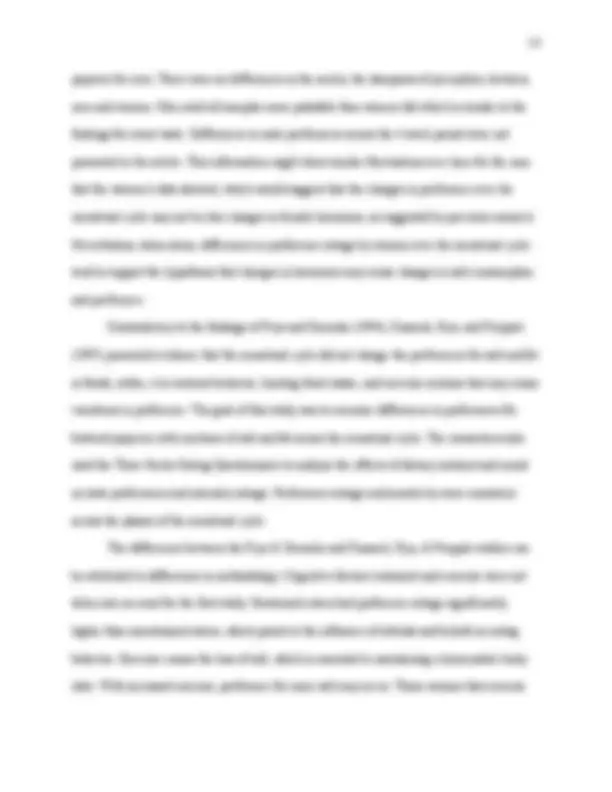
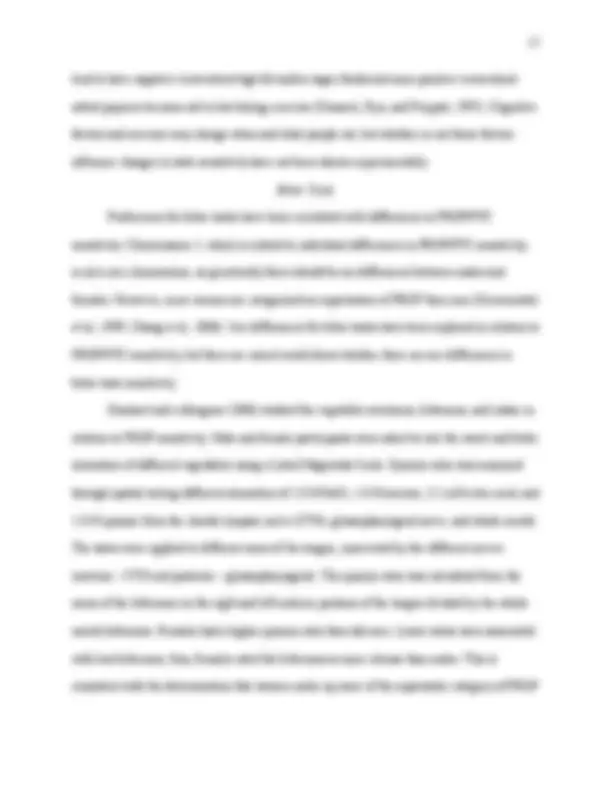
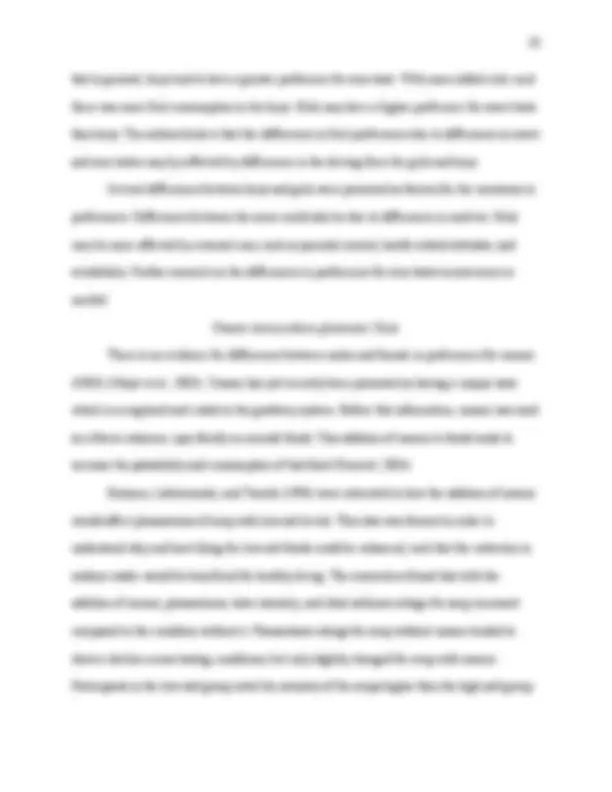
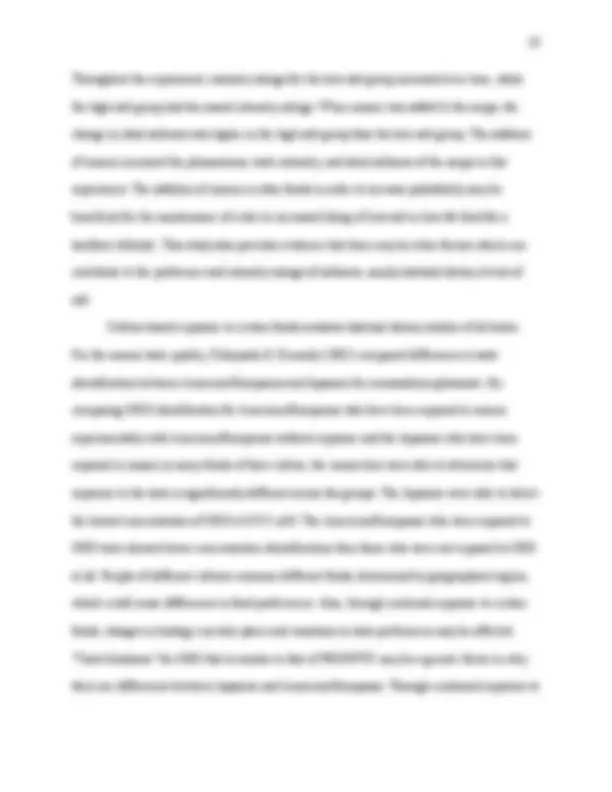
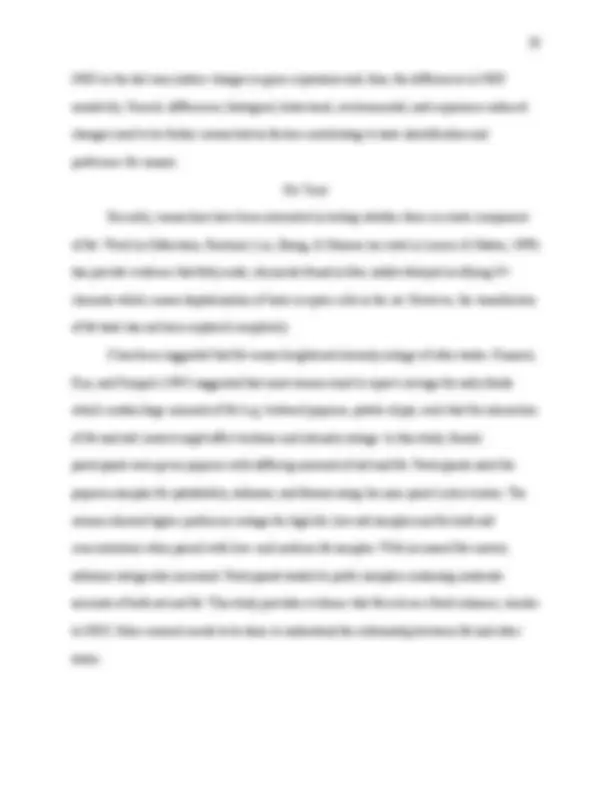
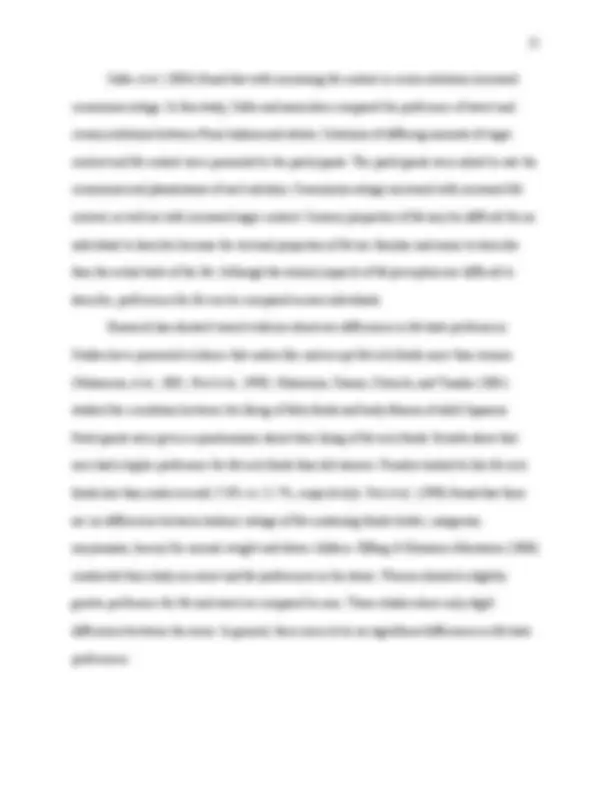
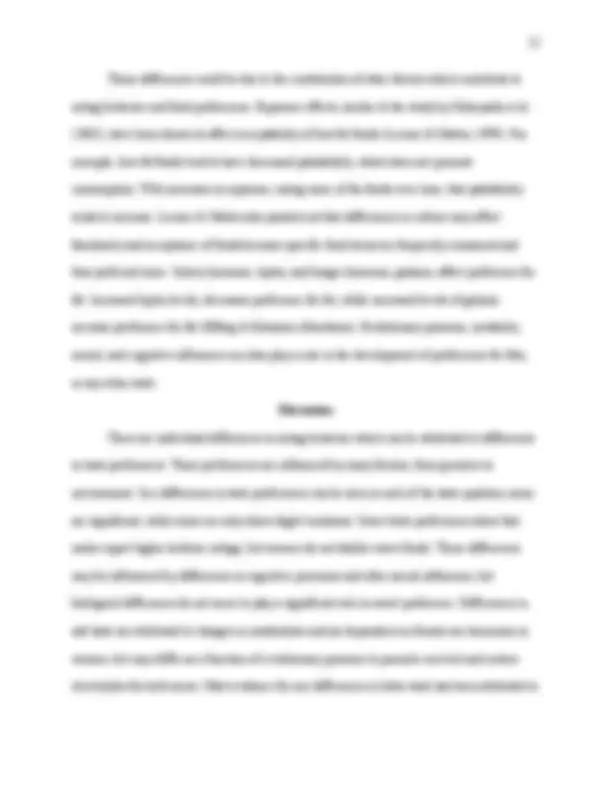
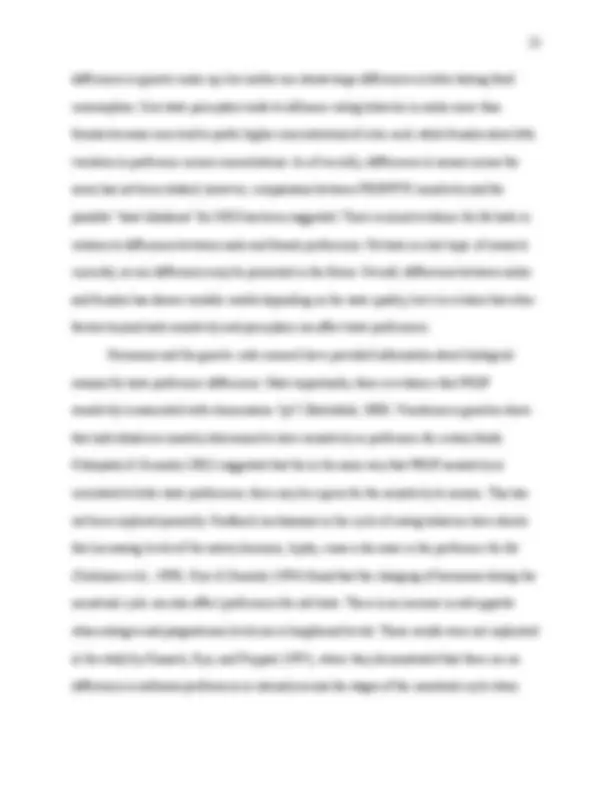
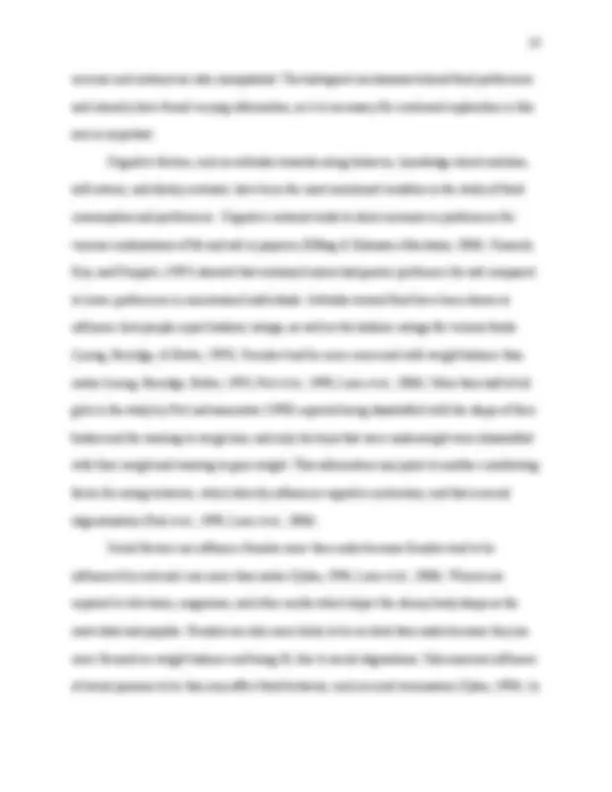








Study with the several resources on Docsity

Earn points by helping other students or get them with a premium plan


Prepare for your exams
Study with the several resources on Docsity

Earn points to download
Earn points by helping other students or get them with a premium plan
Community
Ask the community for help and clear up your study doubts
Discover the best universities in your country according to Docsity users
Free resources
Download our free guides on studying techniques, anxiety management strategies, and thesis advice from Docsity tutors
An in-depth analysis of research on sex differences in taste preferences for various tastes, including sweet, salt, sour, bitter, and umami. The role of genetics, hormones, and other factors in shaping taste preferences and eating behavior. It also explores the implications of these findings for diet and health.
Typology: Papers
1 / 30

This page cannot be seen from the preview
Don't miss anything!























Sex Differences in Taste Preferences in Humans Cameron Corbin Fall 2006
A critical literature review submitted in partial fulfillmentof the requirements for senior research thesis.
Abstract This critical literature investigates differences in taste preferences and acceptability between male and female humans. There is evidence for sex differences in sweet, salt, sour, and bitter tastes, but research in umami and fat tastes have not yet shown differences. Males tend to report higher hedonic ratings for sweet foods than do women, but the difference is not significant. Female sex hormones and metabolism differences account for differences between males and females for the salt taste quality. The differences in bitter taste preferences between the sexes is due to differences in genetics, rather than taste sensitivity. Males show increased liking for sour food items compared to women, which influences consumption of fruit and other sour tasting foods. Umami and fat tastes have only recently been explored, so evidence for sex differences has have not shown differences or similarities between the sexes, yet. Future research may present evidence for differences. There are other factors besides taste sensitivity may contribute to eating behavior, which could better illustrate preference differences between males and females. These factors include cognitive restraint, attitudes toward foods, nutritional knowledge, social influence, culture-based exposure, and biological or genetic factors. Each of these factors could influence individual differences in taste perception. Continued research in on sex differences should be preformed such that if there are differences, more information can be added to the body of knowledge. Through the addition of other contributing variables, a more rounded understanding of eating behavior could be established. The evidence presented in this review suggest that individual differences are more important to differences in taste preferences than sex differences. There is more variability between individuals than there is between males and females.
questionnaire. These measurements of food intake allow the participants to self-report the number of meals, duration of meals, and meal content. The information provided here is important to research because it provides evidence for eating behavior that is not measured directly in the lab or by observers. Food inventories, such as the Food Frequency Questionnaire, the Household Food Inventory, and the Three Factor Eating Questionaire (TFEQ) (Kanarek, Ryu, & Przypek, 1995; Elfhag & Erlanson-Albertsson, 2006) provide more information about the kinds of foods people eat and prefer through the presentation of a list of food items in categories. These self-reported methods only provide subjective analysis of eating behavior. In order to characterize the physical nature of eating behavior and taste perception, methodologies are used that describe the sensation and perception of specific taste stimuli. Sensory tests (taste tests) are valuable techniques because they provide information about the actually taste quality of food, as well as how the person feels about that particular item. A common method of taste testing is the sip-and-spit method (Klein, Schebendach, Devlin, Smith, & Walsh, 2006; Drewnowski, Henderson, Levine, & Hann, 1999). This involves the subject taking in a small amount of solution into their mouth, tasting it, and providing a hedonic rating for that stimulus. The participant then spits out that solution, so that ingestion of the solution will not affect preference ratings due to post-ingestive cues. This is a form of sham feeding, which is used in research with non-human animals. This technique allows for whole mouth sensations, which is different from simply placing a stimulus in one area of the tongue and measuring taste sensation. Whole-mouth methodologies are similar to typical eating behavior, so they provide valid information about taste perception and eating behavior. Beyond sensory tests, taste perception can be measured using nerve recordings, which been used in rats, mice, and other non-human animals (Kossel et al., 1997; Danilova, et al., 2002; He et al, 2002)
Although taste tests can provide information about how a person senses and perceives taste stimuli, it is difficult to perform physiological tests on humans. Physiological measures of the taste system require surgery, nerve recordings, and other measures that are not ethical. Animal models, such as mice, rats, monkeys, etc., are easier to perform because the conditions are better controlled and easier to perform. There are correlations between the animal taste systems and the human taste system allows information to be translated from the animal research to humans. Gustatory Transduction The five commonly accepted taste qualities are sweet, salt, bitter, sour, and umani (MSG). Each of these tastes cause a sensation within the oral cavity that is conducted through nerves to the brain where perception occurs. In general, the chemicals which make up food are detected by taste receptor cells within the taste buds of the mouth after being dissolved in saliva. The taste buds are located within the fungiform papillae located on the tongue surface. Sweet and bitter tastes cause metabotropic transduction, such that when the chemical stimulus interacts with the taste receptor cell, a G-protein is activated. This increases the amount of calcium within the cell and there is depolarization of the cell. Salty and sour tastes depolarize the cell through ionotropic transduction. When salt is present, sodium (Na+) enters the cell and causes depolarization. Acids (sour taste) block K+ channels, preventing K+ from exiting the cell, and thus, the cell becomes more positive. Through each of these types of transduction, the depolarization of the cell causes the release of neurotransmitters into the synapse. The neural signal from the taste receptor cells travels through the cranial nerves (VII, IX, and X) to the brainstem, and then on to other parts of the brain.
receptors, thus the activation could enhance the sensation of the stimulus and could affect the perception of that stimulus. The high intensity ratings given to the PROP/PTC stimulus gives evidence that there are differences in the receptor activation, which can cause individualistic differences in food preferences and intake. Tasters and supertasters tend to avoid bitter substances because they are too intense. Food such as broccoli, soy, Brussels sprouts, and green tea are examples of food items that may be avoided or rejected by tasters (Drewnowski et al., 1999; Fackelmann, 1997). These foods generally contain valuable nutrients, which may guard against cancer, and have more antioxidants which are good for the body. Diets with deficiencies of these nutrients put these people at a higher risk for health problems, such as heart disease and obesity. An understanding of the genetics behind PROP/PTC can help demonstrate individual differences in diets, as well as a better understanding of how genetics directly influence taste sensations, perceptions, preferences, and food intake. Factors that Influence Eating Behavior There are a variety of factors which influence what, how, and why people eat the foods that they consume. As stated above, genetics is the underlying influence in gustation. The genetic code provides the information about how taste buds, taste receptor cells, and fungiform papillae are created. Differences in structure could affect food preferences and detection thresholds. It is also been postulated that evolutionary factors contribute to taste preferences; humans have an innate preference for sweet foods because the sweet food items activate a natural reward system which gives the individual positive reinforcement. These foods also provide valuable energy for survival (De Graaf & Zandstra, 1999). Salt is also necessary for adequate body functioning so a preference for salty food is also supported by evolutionary pressure. Bitter and sour tastes tend to
signal danger or death, which has been assumed to be the reason that humans do not have an innate liking for these substances. Poisonous plants tend to be bitter tasting and should be avoided by humans in order to survive. Decaying animals have a sour taste which could signal the human to avoid eating the animal because it could make it sick. Evolutionary pressure has created a general liking for foods that contain sugar and salt because they provide valuable nutrients to promote survival, while bitter and sour foods provide signals for foods that may threaten survival. A reward system can influence individual differences in eating behavior. Simply stated, food which causes positive emotional responses will be more likely to be eaten again in the future, while the opposite is true for negative responses. The role of emotional value in taste perception is a key factor in understanding eating behavior because it tends to drive food intake more than the nutritional value of the food items being eaten. The component of emotion in which they speak corresponds with the pleasure or displeasure induced by food ingestion. Differences in emotional responses have been compared between the sexes in order to determine if the hypothesis that women are generally more emotional than men. Food cravings and the susceptibility of having impaired control over eating behavior may be associated with the mood altering effects of palatable foods (Kampov-Polevoy, Alterman, Khalitov, & Garbutt, 2006). Throughout the menstrual cycle, women may experience changes in mood. During depressed periods, women may have increased cravings for carbohydrates, specifically for chocolate, cake, pastries, ice cream, and other high-sugar foods (Bowen & Grunberg, 1990; Kanarek, Ryu, & Przypek, 1995; Robin, Rousmans, Dittmar, & Vernet-Maury, 2003). These cravings may be due to changes in the opioid system, which may encourage the seeking of palatable foods such that the depressed mood may be elevated because of the high
Preferences of Different Taste Qualities Sweet Taste Preference for sweet foods is related to evolutionary pressure, genetics, and environmental influences (Reed & McDaniel, 2006; Liem & Mennella, 2002). Foods containing sucrose tend to be eaten in order to provide valuable energy for survival. Genetic factors that determine taste system structure and function could account for individual differences. Experience with sweet foods may affect how much and when sweet foods are consumed can change preferences for these foods over time. These factors may only affect individual preferences and perception of sweet tastes, rather than differences between more general group categories, such as sex, age, and race. There has been conflicting evidence for gender differences in sweetness preference and intensity. Researchers have found that there are no significant differences for the perception of sweetness between males and females (Dinehart, Hayes, Bartoshuk, Lanier, & Duffy, 2006). Participants showed no difference in the ability to detection and distinguish sucrose from other tastes qualities and water (Chang, Chung, Kim, Chung, & Kho, 2006). Preferences for sweets did not differ between males in females in experiments by Elfhag & Erlanson-Albertsson (2006) and Mojet, Heidma, & Christ-Hazelhof (2003). There is much evidence that there are no significant differences between sexes in regards to the sweet taste. In contrast to evidence for supporting sex equality in sweet taste detection, studies have presented several differences in the ratings of sweetness between males and females. Laeng, Berridge, & Butter (1993) tested differences in pleasantness for sweet during hunger and satiety states. Participants were given samples of a lime drink with 4 different concentrations of sucrose. Intensity and pleasantness of the solutions were recorded by each participant. Males tended to
give higher hedonic ratings than did females. Females, on the other hand, showed a negative hedonic ratings at the extremities (4.5% and 36%), with increased hedonic ratings for concentrations in between. In general, women tended to have greater alliesthesia, the perception of the same stimulus as being sometimes pleasant and sometimes unpleasant. Salbe, DelParigi, Pratley, Drewnowski, & Tataranni (2004) focused their study on the taste differences and body weight changes for Pima Indians and whites. They found that in general males preferred sweeter solutions than did females (Frye & Demolar, 1994), but that women tended to rate the solutions as sweeter. In a study by Perl, Mandic, Primorac, Klapec, & Perl (1998), differences in food preferences between normal and obese children showed that normal-weight boys rated sweets (chocolate, cookies, honey, etc.) as having a significantly higher hedonic rating than normal- weight girls. Overall, sex differences in sweet taste have been shown for the preferences and hedonic ratings for the sweet taste quality, but not for the ability to perceive the taste. There are no differences in how tastes are perceived. Preferences and hedonic ratings show that men like sweet food items better than females. Although there are differences in liking for both sexes, sweetness is preferred at medium sweetness, not at the extremes. Sweet taste preferences and hedonic ratings may be influenced by many factors, but it remains clear that there are differences between males and females. Salt Taste Salt foods, like sweet foods, are important to survival. Cells in the body require the presence of sodium in order to function, thus, it is logical to think that preferences and consumption of salt would be generally high across humans. Preferences for salty foods have been researched in regards to differences between sexes and age effects.
males and females are different; these responses could affect perception and preference for different taste qualities. The menstrual cycle is associated with fluctuations in mood, emotions, and nutritional needs of females. A difference in sensitivity to NaCl in female rats has shown that during times of peak estrogen levels sensitivity is decreased, and that female rats are more sensitive to the taste of dilute NaCl solutions regardless of estrogen status (Curtis & Contreas, 2006). Increased consumption of sodium during high estrogen conditions may suggest that NaCl intake may compensate for fluid and electrolyte loss (Curtis & Contreas, 2006). Changes in estrogen levels may affect taste preferences for salt in order to promote survival of a baby if the female becomes pregnant in order to restore lost nutrients. The following studies look at changes in salt preferences and intake across the menstrual cycle in female humans. Frye and Demolar (1994) demonstrated that menstrual cycle does affect salt palatability and intake. Participants in this study were presented 5 concentrations of salt on popcorn and asked to rate its palatability and saltiness on a 100-pt. Lickert scale. The study was conducted over 4 weeks, which coincides with the typical menstrual cycle. Preferences for salt were significantly different across different points of the cycle. Women rated the saltiest (3M+) popcorn much less palatable during menstrual week, while preference for unsalted (0M) popcorn was the highest in the follicular week. Although the preferences during the follicular phase are not consistent with the idea that increased salt consumption during this phase is compensatory, there is still sensitivity to dilute NaCl (Curtis & Contreas, 2006), which would account for the decreased preference for salty popcorn. When compared to the preferences for the same concentrations, men showed a significantly higher preference for the 2M salt concentration than did the women. There was also an increased preference for the unsalted and mildly salted
popcorn for men. There were no differences in the acuity, the sharpness of perception, between men and women. Men rated all samples more palatable than women did which is similar to the findings for sweet taste. Differences in male preferences across the 4 week period were not presented in the article. This information might show similar fluctuations over time for the men that the women’s data showed, which would suggest that the changes in preference over the menstrual cycle may not be due changes in female hormones, as suggested by previous research. Nevertheless, taken alone, differences in preference ratings by women over the menstrual cycle tend to support the hypothesis that changes in hormones may cause changes in salt consumption and preference. Contradictory to the findings of Frye and Demolar (1994), Kanarek, Ryu, and Przypek (1995) presented evidence that the menstrual cycle did not change the preferences for salt and fat in foods; rather, it is restraint behavior, limiting food intake, and exercise routines that may cause variations in preference. The goal of this study was to examine differences in preferences for buttered popcorn with mixtures of salt and fat across the menstrual cycle. The researchers also used the Three Factor Eating Questionnaire to analyze the effects of dietary restraint and mood on taste preferences and intensity ratings. Preferences ratings and sensitivity were consistent across the phases of the menstrual cycle. The differences between the Frye & Demolar and Kanarek, Ryu, & Przypek studies can be attributed to differences in methodology. Cognitive factors (restraint) and exercise were not taken into account for the first study. Restrained eaters had preference ratings significantly higher than unrestrained eaters, which points to the influence of attitude and beliefs on eating behavior. Exercise causes the loss of salt, which is essential to maintaining a homeostatic body state. With increased exercise, preference for more salt may occur. Those women that exercise
sensitivity. The authors determined that PROP sensitivity was significantly correlated to bitter taste perception. PROP sensitivity seems to be a major factor that influences preferences for bitter tastes. Increases sensitivity to PROP means that a person as a heightened sensitivity to bitter substances. Bitter substances tend to be correlated to death or danger through evolutionary evidence and there is an innate avoidance of such tastes. Avoidance is seen in the finding that participants that are considered supertasters tend to consume less of bitter substances, such as broccoli, Brussels sprouts, and cabbage. This eating behavior is directly linked to how the substance tasted. Other factors may contribute to the eating of bitter foods because not all individuals who are sensitive to PROP avoid all bitter substances. There are also influences of texture and nutritional value which may alter eating behavior. Most healthy foods contain chemicals that have a bitter taste (Drewnowski et al., 1999) which could adjust a person’s consumption of these foods even though the bitter substances are disliked. Vegetables tend to be bitterer than any other food group, thus differences in vegetable preferences and taste sensitivity to different vegetables has provided evidence that there are no sex differences bitter tastes. Perl et al. (1998) explored the hedonic ratings of different foods by normal-weight and obese children. They found no significant differences in vegetable (kale, cabbage, spinach, lettuce, green pepper, etc.) ratings. Although some vegetables have a bitter taste, differences in vegetable rating cannot be directly applied to the question of whether bitter tasting foods are perceived as different for males and females. When taste sensitivity was explored in relation to menstrual cycle and pregnancy, changes in bitter sensitivity may be due to changes in hormone levels. Kölble and associates (2001) investigated the gustatory and olfactory sensitivity in the first trimester of pregnancy
versus women who were not pregnant. Pregnant women showed increase sensitivity to bitter foods compared to non-pregnant women. The change in sensitivity is due to changes in the hormone progesterone. The increase may be associated with the need to protect the fetus from presumed bitter-tasting toxins. Differences across the menstrual cycle provide evidence that women may have different taste sensitivities to bitter substances depending on changes in hormones. Changes in sensitivities to bitter tastes were not discussed in this study; however, this does provide a direction for more research. Overall, bitter taste preferences are dependent on individual differences in genetic makers (PROP/PTC) (Kaminiski et al., 2000), taste sensitivity shown in intensity ratings (Mojet et al., 2003; Dinehart et al., 2006), and detection and recognition (Chang et al., 2006). Significant sex differences were not found in the research presented here; however, there is evidence that women have changes in bitter sensitivity due to changes in hormones. This evidence points out the possibility that men and women may differ in bitter taste preferences due to metabolic changes. Sour Taste There is little research in the area of sex differences in sour taste preferences. One major study by Liem, Bogers, Dagnelie, & de Graaf (2006) investigated whether there are differences among children for the balance between sweet and sour taste, and whether such preferences are related to consumption of fruit. Preferences for sweet are related to the consumption of sweet tasting food items, and the same is true for sour tastes. Fruit contains both tastes, so researchers have argued about which taste is most effective in predicting consumption of fruit. Liem and colleagues argue that there maybe an optimal balance between sweet and sour taste which will influences fruit consumption. With fifty participants (25 females, 25 males), the authors found
Throughout the experiment, intensity ratings for the low-salt group increased over time, while the high-salt group had decreased intensity ratings. When umami was added to the soups, the change in ideal saltiness was higher in the high-salt group than the low-salt group. The addition of umami increased the pleasantness, taste intensity, and ideal saltiness of the soups in this experiment. The addition of umami in other foods in order to increase palatability may be beneficial for the maintenance of a diet or increased liking of low-salt or low-fat food for a healthier lifestyle. This study also provides evidence that there may be other factors which can contribute to the preference and intensity ratings of saltiness, mainly habitual dietary levels of salt. Culture-based exposure to certain foods mediates habitual dietary intakes of all tastes. For the umami taste quality, Kobayashi & Kennedy (2002) compared differences in taste identification between American/Europeans and Japanese for monosodium glutamate. By comparing MSG identification for American/Europeans who have been exposed to umami experimentally with American/Europeans without exposure and the Japanese who have been exposed in umami in many foods of their culture, the researchers were able to determine that exposure to the taste is significantly different across the groups. The Japanese were able to detect the lowest concentration of MSG at 0.925 mM. The American/Europeans who were exposed to MSG taste showed lower concentration identifications than those who were not exposed to MSG at all. People of different cultures consume different foods, determined by geographical region, which could cause differences in food preferences. Also, through continual exposure to certain foods, changes in biology can take place and variations in taste preferences may be affected. “Taste blindness” for MSG that is similar to that of PROP/PTC may be a genetic factor in why there are differences between Japanese and American/Europeans. Through continued exposure to
MSG in the diet may induce changes in gene expression and, thus, the differences in MSG sensitivity. Genetic differences, biological, behavioral, environmental, and experience-induced changes need to be further researched as factors contributing to taste identification and preference for umami. Fat Taste Recently, researchers have been interested in testing whether there is a taste component of fat. Work by Gilbertson, Fontenot, Liu, Zhang, & Monroe (as cited in Lermer & Mattes, 1999) has provide evidence that fatty acids, chemicals found in fats, inhibit delayed rectifying K+ channels which causes depolarization of taste receptor cells in the rat. However, the transduction of fat taste has not been explored completely. It has been suggested that fat causes heightened intensity ratings of other tastes. Kanarek, Ryu, and Przypek (1995) suggested that most women tend to report cravings for salty foods which contain large amounts of fat (e.g. buttered popcorn, potato chips), such that the interaction of fat and salt content might affect hedonic and intensity ratings. In this study, female participants were given popcorn with differing amounts of salt and fat. Participants rated the popcorn samples for palatability, saltiness, and fatness using the nine-point Lickert scales. The women showed higher preference ratings for high-fat, low salt samples and for both salt concentrations when paired with low- and medium-fat samples. With increased fat content, saltiness ratings also increased. Participants tended to prefer samples containing moderate amounts of both sat and fat. This study provides evidence that fat acts as a food enhancer, similar to MSG. More research needs to be done to understand the relationship between fat and other tastes.